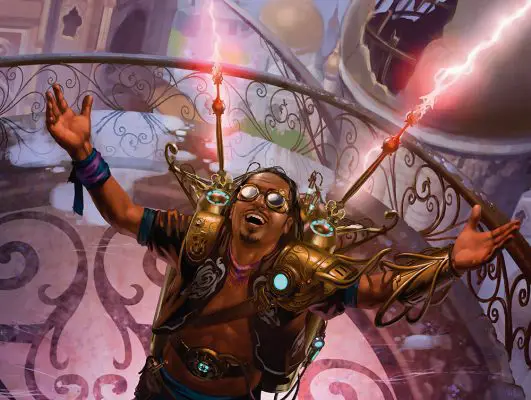
Magic: The Gathering has unheard of longevity. While several other collectible and trading card games have fallen by the wayside, Magic still goes strong. Their latest edition Kaladesh has a distinct style and a few new unique mechanics. Wizards was able to get Mark Rosewater (along with their creative team for the first question) about what makes Kaladesh different from their other sets.
The art of Kaladesh seems to have what I would consider a mystical yet mechanical feel to it. How did the setting come about?
After the darkness of Innistrad, we wanted to visit a world that was bright and filled with optimism. As Doug Beyer notes in The Art of Magic: The Gathering – Kaladesh, “Kaladesh came about when a cluster of ideas began orbiting each other. What if Magic explored steampunk, but with a cultural twist? What if we built a set around artifacts, but focused on their beauty and usefulness to people, rather than their deadliness? What if we did a setting inspired by India, and made it Chandra Nalaar’s origin plane? All of those sounded great—but what if these were all the same plane?” The team loved these ideas, and put them into practice. Thus was born Kaladesh!
Most of the previous sets have introduced one or two mechanics into the game. You are introducing four brand new mechanics this set. Is this too many mechanics at one time?
Kaladesh has three new mechanics (Energy, Fabricate and Vehicles). That number is actually a decrease from recent large sets. For example, Shadows over Innistrad had five mechanics (Delirium, Investigate, Madness, Transform and Skulk) while Battle for Zendikar had six (Landfall, Awaken, Ingest, Rally, Converge and Devoid). We felt we’ve been creating slightly too many keywords in recent sets, so Kaladesh is the start of us ratcheting down that number.

Illustrated by Chris Rallis
For fabrication, will only two options be available to choose from, or will some cards have more options?
Fabricate will only ever have two options: you can choose to make artifact creature tokens, named Servos, or you can create +1/+1 counters that make the creature with Fabricate larger.
Energy introduces a new resource besides mana. How prominent will we see energy used within the set?
Energy is the largest mechanic in the set. There are forty-seven cards that produce and/or use energy.
Vehicles and pilots give a simple way to create combos. Is this a way to help newer players understand how to combo cards?
Yes. We try hard to make sure every Magic set has some obvious (and usually flavorful) combos so that less experienced players can find them. We also include more nuanced combos for our experienced players to search and find. Also, because Magic is modular in nature, our players can find cool combos that we never planned.

Illustrated by Kirsten Zirngibl
Will the pilots from each faction have different benefits for the vehicles?
Each pilot, regardless of which faction they are from, will do something unique when it is piloting a Vehicle. This will give players who want to create a Vehicle themed deck a number of different options of how to build it.
With the ability to create new tokens, are there any worries that this mechanic may prolong the game end?
One of the nice thing about making tokens is that you can use them aggressively as well a defensively. Kaladesh also has a few cards that help enhance your token army so that you can attack in a large swarm and win the game.
Will all of these mechanics find themselves in the next upcoming future sets?
Some to all of the mechanics from Kaladesh will appear in Aether Revolt, the companion set to Kaladesh. When we start a new block (as we will next spring with Amonkhet) we traditionally introduce a brand new suite of mechanics.
The Kaladesh set is available now online and at local game stores. The illustrations look great, and the mechanics are definitely intriguing.